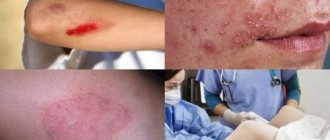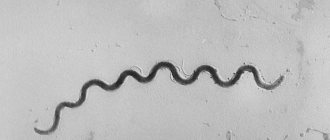It is safe to say that none of the infectious diseases (not even smallpox and the plague) was surrounded by such an ominous aura as syphilis.
The extremely dark reputation of the main “bad disease,” as venereal diseases were called not so long ago, was due to two factors:
- firstly, syphilis before the era of antibiotics often led to the death of the patient or to severe disability and disfigurement of appearance,
- secondly, in the overwhelming majority of cases, infection with syphilis occurred during casual sexual contact (as a rule, during unprotected sex with girls of easy virtue, which caused a strong feeling of guilt in the sick person).
The origin of the disease is still unknown: some scientists believe that syphilis was brought by the sailors of Columbus’s caravels from the newly discovered America, other researchers insist that syphilis existed in Europe in the pre-Columbian era.
After the invention of penicillin and other antibiotics, syphilis ceased to be a deadly disease - but this sexually transmitted disease did not disappear anywhere. Since approximately 2000, there has been an increase in the incidence of syphilis in many countries, including the US, UK, China and European countries.
And now cases of latent syphilis, which remain asymptomatic for a long time, and the congenital form of the disease, when the causative agent of syphilis is transmitted from a sick mother to the fetus, pose a particular danger.
Against this rather gloomy background, one can find the only relatively “bright spot”: the causative agent of syphilis, Treponema pallidum, continues to remain highly sensitive to the action of penicillin, the oldest of antibiotics, and to the action of its derivatives (ampicillin, amoxicillin and others).
From all that has been said, two main conclusions can be drawn:
- Now syphilis is completely curable - the main thing is, if specific symptoms are detected, contact a venereologist as soon as possible,
- safe sex with a condom, which is now widely promoted as a means of preventing HIV/AIDS, also reliably protects against infection with syphilis, gonorrhea and almost two dozen other infections known as STDs (sexually transmitted diseases).
Symptoms
The incubation period is asymptomatic. It begins from the moment the pathogen enters the body and lasts an average of 3 weeks until the first signs of syphilis appear. Each stage of the disease has its own characteristics.
Primary syphilis
The most characteristic manifestation of this stage is the formation of the so-called hard chancre, which is a raised ulcer that does not cause pain (Fig. 1). Most often, a chancre forms at the site of entry of the pathogen and goes away after some time (on average, 3-5 weeks).
Figure 1. Chancroid. Source: Jianjun Qiao/Hong Fang/CMAJ
The most common sites of ulceration are the genitals, anus, and lips. It should be remembered that syphilis is not only transmitted sexually - infection can occur through a cut or abrasion, so chancre can appear on almost any part of the body. Another characteristic feature of this stage is enlarged lymph nodes.
Secondary syphilis
Usually this stage begins 2 months after infection. It is characterized by skin rashes all over the body (Fig. 2). They are explained by the body’s immune response to the penetration of the pathogen. Internal organs and bone tissue are affected, the temperature may rise slightly, and a feeling of aching occurs throughout the body. Lymph nodes enlarge and become dense. Syphilis is contagious at any stage, but it is this stage of the disease that is considered the most dangerous in terms of transmission of infection.
Figure 2. Syphilis rash. Source: Jianjun Qiao/Hong Fang/CMAJ
After the second manifestation, syphilis again goes “underground”, and a period of latent disease begins, which can last for many years. However, the absence of symptoms does not mean recovery; without treatment, sooner or later the infection will manifest itself again, this time in a much more dangerous form.
Tertiary syphilis
Lack of treatment in the early stages leads to the development of the last, third stage of syphilis, when the infection affects almost all the patient’s internal organs, his nervous system, bones and skin.
Tertiary syphilis disfigures a person and can completely deprive him of his vision. A characteristic feature of the last stage of the disease is the formation of gummas, which are soft tumors. Syphilis often affects the brain, resulting in impaired coordination of movements, developing dementia, motor and sensory disorders. Most of these changes are irreversible.
Table 1 briefly summarizes the stages of syphilis and characteristic symptoms.
Table 1. Stages and symptoms of syphilis
| Stage | Time after infection | Symptoms | Contagiousness of the patient |
| Incubation period | 8 – 180 days (most often – 3 weeks) | There are no external manifestations at this stage | + (men are more often contagious) |
| Primary syphilis | 5-7 weeks after the end of the incubation period | Enlarged lymph nodes and the formation of painless ulcers, most often located in the genital area | + |
| Secondary syphilis | 8-10 weeks | Rash all over the body (most often painless), slight fever, joint and muscle pain, weakness | + |
| Tertiary syphilis | 1-2 years | Formation of soft tumors (gummas), organ deformation, irreversible damage to the nervous system | + |
Important! Syphilis is contagious even during the so-called “seronegative window”, when a person has already become infected, but laboratory tests are not yet able to detect it, and the patient does not experience any symptoms.
Characteristics of the last stage
Tertiary syphilis manifests itself either after three to four years, or ten or more years from the time of infection. Most often, this stage is caused by insufficient therapy or incorrect dosage of medications. A significant role is played by the patient’s negligence and indiscipline, since it is difficult not to notice the signs of syphilis. There are individual situations when the disease starts due to its latent manifestation, in which the symptoms are not expressed. There are also a small number of cases (three to five percent) when syphilis progresses to the tertiary period, even with timely and competent treatment.
The occurrence of late stage syphilis is influenced by various factors. For example, if the body is weakened by any serious diseases, then the pathology may further worsen (for example, with hepatitis, tuberculosis or serious inflammatory processes). Drug addiction, alcoholism, living in conditions that do not meet sanitary standards, hard physical labor in the absence of rest, and strong and frequent emotional shocks can also have an impact.
Diagnostics
Diagnosis of syphilis consists of detecting the causative agent of the disease, Treponema pallidum, in the body, by direct or indirect methods. In the first case, the bacterium itself is determined (Fig. 3), and in the second, the blood is examined for the presence of antibodies to it (IgM/IgG).
Figure 3. Treponema pallidum. Source: CDC/David Cox
Initially, the Wasserman reaction was used to confirm the diagnosis, which involved the introduction of an antigen into a sample of biomaterial with the formation of specific antibodies.
The undeniable advantage of this method was its ease of implementation, but there was also a big drawback - the reaction often gave a false positive result. Today this method is considered obsolete. It should be understood that even modern methods have both advantages and disadvantages (Table 2). Table 2. Methods for diagnosing syphilis
| Diagnostic methods | Material for research | Advantages | Flaws |
1. Straight:
| Patient tissue samples, chancre discharge | Simplicity, low cost and ease of implementation | Not relevant when identifying late and latent forms of the disease |
| 2. Indirect: 2.1 Non-treponemal:
2.2 Treponemal:
| Blood serum, capillary blood from a finger (only for express methods) | Convenience, low cost, ability to control cure | Lack of sensitivity in detecting late forms of the disease, as well as a high percentage of false-positive results |
The doctor chooses diagnostic methods based on the clinical picture and complaints of the patient. Once the diagnosis is confirmed, the patient is registered at the dermatovenereal dispensary. Any sexual relations are excluded, alcohol consumption is prohibited.
Important! In case of a positive test, not only sexual partners, but also all family members should be notified - they will also need to undergo appropriate diagnostics.
Treatment
Treatment of syphilis involves, first of all, influencing the cause, that is, the cause of the occurrence - the causative agent - of the disease (in medicine this is called etiotropic therapy). Conventionally, treatment is divided as follows:
- Specific – prescribed in case of a confirmed diagnosis.
- Preventive – carried out to the sexual partners of a patient with syphilis, or to people who have had contact with his blood.
- A trial is advisable if the doctor suspects syphilitic damage to tissues and organs, but the diagnosis cannot be confirmed using laboratory tests.
- Additional - prescribed for relapse of the disease to patients who previously underwent etiotropic treatment.
However, where to start treatment and which specialist is involved in this?
Drug treatment
Antibiotics are used to treat syphilis - their action is aimed at eliminating the activity of Treponema pallidum. Usually, the doctor prescribes penicillin drugs, but these antibiotics often cause an allergic reaction, so modern treatment of syphilis involves the use of less allergenic antibiotics - for example, from the group of tetracyclines, cephalosporins (ceftriaxone) or macrolides (azithromycin).
Penicillins
Antibiotics of this group have been used in the treatment of syphilis for several decades and during this time they have proven themselves to be excellent - Treponema pallidum has never developed resistance to them. Penicillin is produced in the form of tablets and solution for injection, however, for the treatment of syphilis, the second option is preferable. The patient is given injections once every 3 hours, so treatment is carried out in a hospital setting.
When using penicillin, adverse reactions often occur:
- nausea,
- vomit,
- diarrhea;
- increase in body temperature,
- convulsions.
Important! The most common complication when using penicillin antibiotics is the development of allergic reactions. Most often they manifest themselves in the form of urticaria and swelling.
Penicillin is suitable not only for specific, but also for preventive treatment of syphilis.
Tetracyclines
Antibiotics of this group are most effective in treating the primary and secondary forms of the disease. They are available in the form of tablets, capsules, ointments and solution for injection (tetracycline hydrochloride). When treating syphilis, tablet form is also used - administration is indicated up to 4 times a day. During the course of treatment, it is undesirable to be in direct sunlight, since tetracyclines can increase the skin's sensitivity to ultraviolet radiation. It is very important not to take breaks in taking the drug - in this case, the causative agent of the disease may develop resistance to the antibiotic.
Cephalosporins
When treating syphilis, these antibiotics are used intramuscularly and intravenously. Depending on the severity of the disease, the course of treatment ranges from 5 to 20 days. Cephalosporins can provoke the development of side effects such as digestive disorders, poor sleep and skin rashes. To reduce the risk of their development, it is recommended to take vitamins and probiotics in parallel.
Macrolides
Macrolides can quickly cure the disease in the early stages, but in case of tertiary syphilis their use does not give the expected effect. Simply put, such antibiotics do not kill Treponema pallidum immediately, but gradually make it unviable. The drug is produced in the form of tablets. The dose is indicated once a day, the course of treatment lasts 9-12 days. The dosage is determined by the attending physician, based on the clinical picture, age and anthropometric data of the patient.
Jarisch-Herxheimer reaction when taking antibiotics
While taking antibiotics, the patient may develop the so-called Jarisch-Herxheimer reaction. It may manifest itself with the following symptoms:
- chills,
- increase in body temperature,
- headache,
- cardiopalmus,
- hypotension,
- pain in muscles and joints.
It is important to understand that the Jarisch-Herxheimer reaction is not an allergic reaction and is not a reason to stop treatment. This is an immune response of the body that occurs as a result of the massive death of pathogenic microbes, which is accompanied by the release of endotoxins.
Local treatment
Local treatment for syphilis may include ointments, creams or gels aimed at mitigating the skin manifestations of the disease.
Physiotherapy
Physiotherapy in the treatment of syphilis is used to generally strengthen the body and combat the neurological manifestations of the disease. Physiotherapeutic methods cannot be the main ones in the fight against infection.
Auxiliary treatment
As an auxiliary therapy for the treatment of syphilis, the following is used:
- vitamins,
- dietary supplements,
- immunomodulators.
Such supportive treatment has no effect on the causative agent of syphilis and is only an additional measure in the fight against the disease.
Traditional methods
There are no traditional methods for treating syphilis. Self-treatment of syphilis does not give the desired effect. The treatment regimen should only be determined by a specialized specialist.
Mercury: is it used now?
The oldest method of treatment is the use of mercury (both orally and in the form of ointments). Mercury effectively destroys Treponema pallidum, but at the same time, due to its high toxicity, it also has a destructive effect on the patient’s body. Mercury was used to combat syphilis for several centuries until the middle of the last century. Currently, mercury preparations are prescribed extremely rarely due to the large number of side effects.
Treatment of pregnant women
If syphilis is detected in a pregnant woman, medical tactics will depend on the duration of pregnancy and the severity of the disease. In some cases, there is a high risk of the child developing severe congenital pathologies, then it is recommended to terminate the pregnancy. However, antibiotic treatment is most often prescribed. If therapy is started in a timely manner, the prognosis for the child is most often favorable.
Read more about the treatment of syphilis in pregnant women in the article “Syphilis in women.”
Treatment at different stages of the disease
Depending on the stage of syphilis, medical tactics differ. In the early stages, antibiotics are prescribed, and if treatment was started in a timely manner, this approach gives the expected result. In the later stages, when pathological changes occur in the internal organs, hospitalization is required; many patients are forced to undergo inpatient treatment for several months.
Additionally, bismuth and arsenic preparations may be prescribed, and in case of serious changes in tissues and organs, surgical intervention may be required at the end of therapy.
Important! The sooner treatment is started, the faster the disease can be cured.
At the end of treatment, it is necessary to take control serological tests to ensure that the patient is completely healthy. Untreated syphilis is fraught with serious complications, so testing after treatment is mandatory.
How long does the treatment last?
If syphilis is diagnosed early, treatment with antibiotics usually takes 2-3 weeks. When using intramuscular drugs, the course may include 1-3 or 5 injections, although there are drugs that need to be injected every 4 hours.
Patients diagnosed with secondary or early latent infection will have to undergo longer therapy - about 28 days. In the case of tertiary or late latent syphilis, the course is even longer; in addition to 28 days of primary therapy, it includes repeated treatment within 14 days, prescribed 2 weeks after completion of the first.
Is it possible to contact people during treatment?
Treatment of syphilis is most often carried out in a hospital, in the infectious diseases department. In the early stages, outpatient treatment at home is possible. In this case, complete isolation is recommended to the patient’s family. If this is not possible, it is necessary to limit contact with the sick person and not share dishes, towels and hygiene products with him. The apartment should be wet cleaned with antiseptics at least 2 times a week.
Important! The patient's sweat and urine are not contagious.
Saliva can become infected if there are syphilitic ulcers in the patient's mouth.
Description of the disease
Syphilis is a chronic venereal disease, spread both sexually and through contact, systemically affecting the body. A distinctive feature of the disease is its cyclical course.
The widespread use of antibiotics (since 1943) has made it possible to completely cure the disease in the primary and secondary stages. The unjustified use of antibiotics in medicine has led to the erosion of the clinical symptoms of the pathology and made the course of syphilis hidden. According to medical statistics, 12-15 million people in the world are infected every year, so the question of how to identify syphilis remains relevant today.
The following cycles of the disease are distinguished:
- Hidden;
- Primary;
- Secondary;
- Tertiary.
Each of these cycles is divided into periods. Primary syphilis is classified depending on the blood test results:
- Seronegative;
- Seropositive.
The second cycle of disease development forms:
- Hidden;
- Fresh;
- Recurrent syphilis.
In the last stage, or tertiary, both latent and active syphilis is observed.
Can syphilis be cured? Forecast
With a timely diagnosis and correct treatment, the prognosis is favorable in most cases. Syphilis is curable in the early stages, as well as in pregnant women in the first trimester. The latent form of the disease is also curable if therapy is started in a timely manner.
In the later stages, it is much more difficult to cure the patient, since in most cases irreversible damage to internal organs occurs, and treatment is mostly aimed at stopping the further development of pathological processes.
Possible complications
Complications of syphilis affect almost all organs and systems. Most often they develop due to late detection of the disease or improper treatment. Here is a list of the most common complications:
- patchy or complete baldness (hair growth may return after treatment),
- phimosis (impossibility of exposing the head of the penis),
- gangrene of the penis,
- scars from skin ulcers,
- fatty degeneration of the kidneys,
- syphilitic hepatitis with subsequent degeneration of liver tissue,
- damage to bone and muscle tissue (the entire musculoskeletal system suffers),
- syphilitic lesions of the heart muscle,
- nasal deformity,
- damage to the nervous system (neurosyphilis) - dementia, paralysis, insomnia, visual and hearing impairment.
In pregnant women, syphilis can lead to premature birth, stillbirth, congenital syphilis in the child, as well as a wide range of fetal pathologies (congenital diseases of the heart, kidneys, gastrointestinal tract, nervous system, etc.). In 2012, 350 thousand pregnancies were complicated worldwide due to syphilis: 143 thousand cases of stillbirths and 62 thousand deaths of newborns were registered, and 102 thousand infants were diagnosed with congenital syphilis.
Prevention
To protect yourself from syphilis infection, you should follow a few simple rules:
- Avoid casual sex. As a last resort, use a condom. It does not provide 100% protection, but it still significantly reduces the risk of disease transmission.
- Use only your own personal hygiene items (such as toothbrushes or towels).
- If one of your family members has contracted syphilis, you should avoid close contact with the infected person, do not share common household items, and regularly disinfect your home.
- In case of accidental sexual contact with a potential or obvious carrier of the disease, you should contact a venereologist - he will prescribe preventive treatment with antibiotics.
Following these preventative measures will help you avoid infection and keep your loved ones safe.
How does infection occur?
How one can get syphilis is a question that should be raised at the government level with educational work for all age groups, from teenagers to older people. Because statistical data (26 people out of a thousand have syphilis) indicate that the population is not informed and that most people believe in myths from Internet resources about how to avoid infection.
For example, it is often believed that a condom protects against infection. This is not true; it reduces the risk of infection, but does not completely protect.
Ways of transmission of infection:
- The sexual route of infection is the most common, accounting for 95% of the total number of cases. This is affected by the pathogen damaging all body fluids, which include vaginal fluid and sperm. Infection occurs when there are tiny cracks in the mucous membranes of the genital organs, through which the bacteria penetrates. Moreover, infection is possible not only during regular vaginal sex, but also during oral and anal sex. Oral sex occurs with the same exchange of body fluids, only with the participation of saliva, which also contains a pathogen. During anal sex, the risk of infection is even higher - the rectum is often affected by microcracks, which simplify the penetration of the pathogen into the body.
- The household route of infection occurs in a minimal number of cases, but the risk of infection exists. Infection can occur through contact with household items on which the patient’s fluids remain. These are dishes with remnants of saliva, bed linen with discharge from ulcers. These things remain at risk of infection until the liquid dries completely.
- The transplacental route of infection occurs only in newborns, since infection occurs from mother to fetus during pregnancy or during childbirth.
- The blood transfusion route of infection is likely when infected blood enters the body of an uninfected person. This can happen during a donor blood transfusion through a syringe with traces of the blood of an infected person.
- The professional route of infection occurs only among medical personnel who have direct contact with patients and come into contact with the fluids of an infected person - blood, saliva, vaginal discharge. The only condition is the presence of skin lesions and the entry of infected fluid into them.
Treponema pallidum infection can occur during kissing.
How to protect yourself from syphilis:
- avoid questionable sexual contacts;
- adhere to the rules of personal hygiene;
- undergo regular STD testing;
- at the slightest suspicion of infection, seek advice from a specialist.
Important. Interruption of sexual intercourse before ejaculation does not protect against infection, since the bacterium is concentrated in the lubricant released during arousal and upon contact of mucous membranes, the risk of infection remains.











